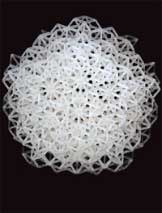A discovery by Princeton researchers may lead to an efficient method for controlling the transmission of light and improve new generations of communications technologies powered by light rather than electricity.

In an experiment, the researchers proved for the first time that quasicrystal structures are better for trapping and redirecting light than ordinary crystals because their structure is more nearly spherical. The quasicrystal design can block light from escaping no matter which direction it traveled.
The finding represents an advance for photonics — in which light replaces electricity as a means for transmitting and processing information — and could lead to the development of faster telecommunications and computing devices. Photonics consumes less energy and is faster than electronics to channel information.
“Controlled light can be directed, switched and processed like electrons in an electronic circuit, and such photonic devices have many applications in research and in communications,” noted physicist Paul Steinhardt.
The researchers are now exploring ways of miniaturizing the structure in order to utilize the device with visible light instead of microwaves. They also are examining whether the quasicrystal designs may be useful in electronic and acoustic applications.
Via PhysOrg. News @ Princeton.
